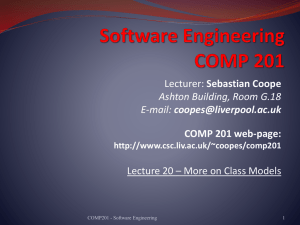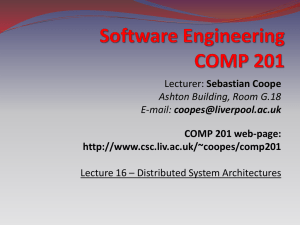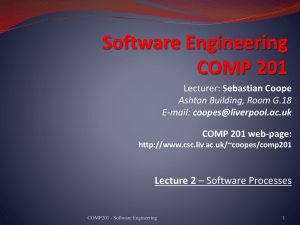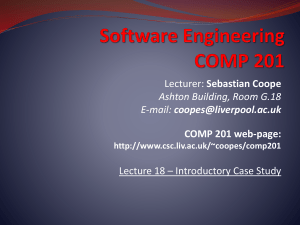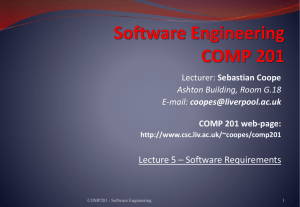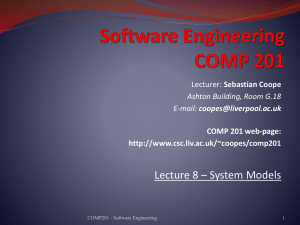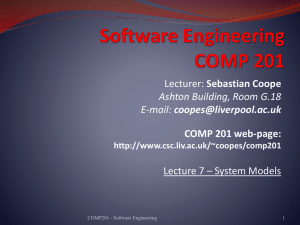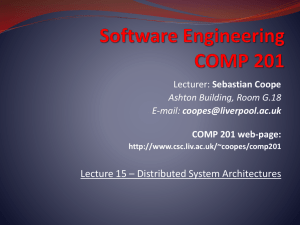SE_L13
advertisement
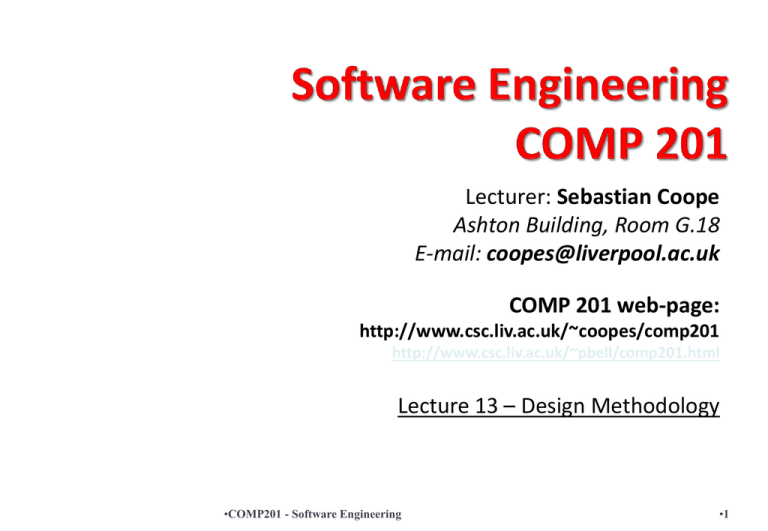
Lecturer: Sebastian Coope Ashton Building, Room G.18 E-mail: coopes@liverpool.ac.uk COMP 201 web-page: http://www.csc.liv.ac.uk/~coopes/comp201 http://www.csc.liv.ac.uk/~pbell/comp201.html Lecture 13 – Design Methodology •COMP201 - Software Engineering •1 Software Design Deriving a solution which satisfies software requirements •COMP201 - Software Engineering •2 Software Design Why Software is produced by many people Software needs to be Simple Understandable Flexible Portable Re-usable How Complex to simple Abstraction •COMP201 - Software Engineering •3 Software Design in Reality Design mixed with implementation Design step 1 Implement and add more design Design step 2 Implement and add more design In effect much of software is designed while coded and the design document doesn’t reflect the final product •COMP201 - Software Engineering •4 Stages of Design Problem understanding Look at the problem from different angles to discover the design requirements. Identify one or more solutions Evaluate possible solutions and choose the most appropriate depending on the designer's experience and available resources. Describe solution abstractions Use graphical, formal or other descriptive notations to describe the components of the design. Repeat process for each identified abstraction until the design is expressed in primitive terms. •COMP201 - Software Engineering •5 The Design Process Any design may be modeled as a directed graph made up of entities with attributes which participate in relationships. The system should be described at several different levels of abstraction. Design takes place in overlapping stages. It is artificial to separate it into distinct phases but some separation is usually necessary. •COMP201 - Software Engineering •6 Phases in the Design Process Re quire me nts spec ifica tion De sign acvities ti Arc hite ctur al design Abstra ct spec ifica tio n Interfa ce design Component design Data structur e design Algorithm design Syste m a rc hite ctur e Softwa re spec ifica tion Interfa ce spec ifica tion Component spec ifica tion Data structur e spec ifica tion Algorithm spec ifica tion De sign pr oducts •COMP201 - Software Engineering •7 Design Phases • • • • Architectural design: Identify sub-systems. Abstract specification: Specify sub-systems. Interface design: Describe sub-system interfaces. Component design: Decompose sub-systems into components. • Data structure design: Design data structures to hold problem data. • Algorithm design: Design algorithms for problem functions. •COMP201 - Software Engineering •8 Design Computer systems are not monolithic: they are usually composed of multiple, interacting modules. Modularity has long been seen as a key to cheap, high quality software. The goal of system design is to decode: What the modules are; What the modules should do; How the modules interact with one-another •COMP201 - Software Engineering •9 Modular Programming In the early days, modular programming was taken to mean constructing programs out of small pieces: “subroutines” But modularity cannot bring benefits unless the modules are autonomous, coherent and robust •COMP201 - Software Engineering •10 Procedural Abstraction The most obvious design methods involve functional decomposition. This leads to programs in which procedures represent distinct logical functions in a program. Examples of such functions: “Display menu” “Get user option” This is called procedural abstraction •COMP201 - Software Engineering •11 Programs as Functions Another view is programs as functions: input output x f f (x) the program is viewed as a function from a set I of legal inputs to a set O of outputs. There are programming languages (ML, Miranda, LISP) that directly support this view of programming Well-suited to certain application domains - e.g., compilers Less well-suited to distributed, nonterminating systems - e.g., process control systems, operating systems like WinNT, ATM machines •COMP201 - Software Engineering •12 Object-Oriented Design • The system is viewed as a collection of interacting objects. • The system state is decentralized and each object manages its own state. •Note , use of internal state against functional programming • Objects may be instances of an object class and communicate by exchanging messages. •COMP201 - Software Engineering •13 Five Criteria for Design Methods We can identify five criteria to help evaluate modular design methods: Modular decomposability; Modular composability; Modular understandability; Modular continuity; Modular protection. •COMP201 - Software Engineering •14 Modular Decomposability Modular decomposability - this criterion is met by a design method if the method supports the decomposition of a problem into smaller sub-problems, which can be solved independently. In general, this method will be repetitive: sub-problems will be divided still further Top-down design methods fulfil this criterion; stepwise refinement is an example of such a method •COMP201 - Software Engineering •15 Hierarchical Design Structure System level Sub-system level •COMP201 - Software Engineering •16 Top-Down Design • In principle, top-down design involves starting at the uppermost components in the hierarchy and working down the hierarchy level by level. • In practice, large systems design is never truly top-down. Some branches are designed before others. Designers reuse experience (and sometimes components) during the design process. •COMP201 - Software Engineering •17 An Example of Top-Down Design • Imagine designing a word processor program from scratch. What subsystems could be initially found at the top level? • File I/O, printing, graphical user interface, text processing etc. • For each of these components we can then decompose further, i.e., File I/O comprises of saving documents and opening documents.. •COMP201 - Software Engineering •18 Modular Composability Modular composability - a method satisfies this criterion if it leads to the production of modules that may be freely combined to produce new systems. Composability is directly related to the issue of reusability Note that composability is often at odds with decomposability; top-down design, for example, it tends to produce modules that may not be composed in the way desired This is because top-down design leads to modules which fulfil a specific function, rather than a general one •COMP201 - Software Engineering •19 Examples The Numerical Algorithm Group (NAG) libraries contain a wide range of routines for solving problems in linear algebra, differential equations, etc. The Unix shell provides a facility called a pipe, written “|”, whereby the standard output of one program may be redirected to the standard input of another; this convention favours composability. •COMP201 - Software Engineering •20 Modular Understandability Abstraction int A=21 int age_in_years = 21; print_out_document(Document d) Modular Understandability - a design method satisfies this criterion if it encourages the development of modules which are easily understandable. COUNTER EXAMPLE 1. Take a thousand lines program, containing no procedures; it’s just a long list of sequential statements. Divide it into twenty blocks, each fifty statements long; make each block a method. COUNTER EXAMPLE 2. “Go to” statements. •COMP201 - Software Engineering •21 Modular Understandability • Related to several component characteristics – Can the component be understood on its own? – Are meaningful names used? – Is the design well-documented? – Are complex algorithms used? • Informally, high complexity means many relationships between different parts of the design. •COMP201 - Software Engineering •22 Modular Continuity Modular continuity - a method satisfies this criterion if it leads to the production of software such that a small change in the problem specification leads to a change in just one (or a small number of ) modules. EXAMPLE. Some projects enforce the rule that no numerical or textual literal should be used in programs: only symbolic constants should be used COUNTER EXAMPLE. Static arrays (as opposed to dynamic arrays) make this criterion harder to satisfy. •COMP201 - Software Engineering •23 Modular Protection Modular Protection - a method satisfied this criterion if it yields architectures in which the effect of an abnormal condition at run-time only effects one (or very few) modules EXAMPLE. Validating input at source prevents errors from propagating throughout the program (design by contract) COUNTER EXAMPLE. Using int types where subrange or short types are appropriate. •COMP201 - Software Engineering •24 A Real Life Example – Ariane 5 Flight 501 The failure of an Ariane 5 space launcher is possibly the most expensive software bug in history at around $370 million. Other bugs have been even worse by causing loss of life, for example Therac-25 radiation machines. •COMP201 - Software Engineering •25 The Ariane 5 Space Launcher While developing the Ariane 5 space launcher, the designers reused a component (the inertial reference software) which was successfully used in the Ariane 4 launcher This component failed 37 seconds into the flight and the ground crew had to instruct the launcher to self-destruct. The error was caused by an unhandled numerical conversion exception causing a numeric overflow. Component reuse is usually a good thing but care must be taken that assumptions made when the component was developed are still valid! •COMP201 - Software Engineering •26 Repository Models Sub systems making up a system must exchange and share data so they can work together effectively. There are two main approaches to this: The repository model – All shared data is held in a central database which may be accessed by all sub-systems Each sub-system or component maintains its own database. Data is then exchanged between sub-systems via message passing. There are advantages and disadvantages to each approach as we shall now see. •COMP201 - Software Engineering •27 Repository Model The advantages include: Databases are an efficient way to share large amounts of data and data does not have to be transformed between different subsystems (they agree on a single data representation). Sub-systems producing data need not be concerned with how that data is used by other sub-systems. Many standard operations such as backup, security, access control, recovery and data integrity are centralised and can be controlled by a single repository manager. The data model is visible through the repository schema. •COMP201 - Software Engineering •28 Repository Model The disadvantages include: Sub-systems must agree on the data model which means compromises must be made, for example with performance. Evolution may be difficult since a large amount of data is generated and translation may be difficult and expensive. Different systems have different requirements for security, recovery and backup policies which may be difficult to enforce in a single database. It may be difficult to distribute the repository over a number of different machines. •COMP201 - Software Engineering •29 Lecture Key Points We have studied five criteria to help evaluate modular design methods and their advantages: Modular decomposability; modular composability; modular understandability; modular continuity; modular protection. We have seen the advantages and the disadvantages of repository models •COMP201 - Software Engineering •30


